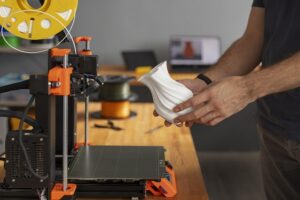
Here are some hacks and tips that can help you improve your print quality, avoid common problems, and increase the efficiency of your 3D printer.
1. Proper Preparation is Crucial:
- Print Bed Calibration:
- Precise print bed calibration is essential for first layer adhesion. Use a sheet of paper to adjust the distance between the nozzle and the print bed.
- Many modern printers have automatic bed leveling, which simplifies this process.
- Print Bed Cleaning:
- Dust, grease, and other contaminants can impair adhesion. Clean the print bed regularly with isopropyl alcohol.
- Filament Storage:
- Moisture can affect filament quality. Store your filament in a dry and dust-free container.
2. Optimizing Print Settings:
- Temperature:
- The correct nozzle and bed temperature depends on the material. Experiment with different temperatures to find the optimal setting for your filament. Print a temperature tower to determine the correct temperature. >>download temptower from thingiverse.com<<
- Print Speed:
- An excessively high print speed can lead to unclean results. Reduce the speed for complex models or fine details.
- Cooling:
- Good cooling is important for printing overhangs and fine details cleanly. Check if your fan is working properly.
- Support Structures:
- Use support structures to support overhangs and complex geometries. Optimize the support structures to save material and facilitate post-processing.
- Slicer Software:
- Use slicer software like Cura or PrusaSlicer. These programs offer many setting options to optimize print quality.
3. Common Problems and Solutions:
- Clogged Nozzle:
- Clogged nozzles can be caused by filament residue or contaminants. Use a nozzle cleaning needle or wire to clean the nozzle.
- Warping:
- Warping occurs when the print object detaches from the print bed. Increase the bed temperature, use an adhesive spray or an adhesive film.
- Stringing:
- Stringing occurs when filament threads form between printed parts. Reduce the nozzle temperature, increase the retraction speed, or optimize the travel movements.
- Poor Layer Adhesion:
- This problem can be caused by incorrect temperature or excessively fast print speeds.
4. Additional Tips:
- Regular Maintenance:
- Clean and lubricate your 3D printer regularly to ensure optimal performance.
- Experimentation:
- 3D printing often requires some patience and a willingness to experiment. Don’t be afraid to try different settings and materials.
By applying these hacks and tips, you can significantly improve your 3D printing results and increase your enjoyment of this fascinating technology.